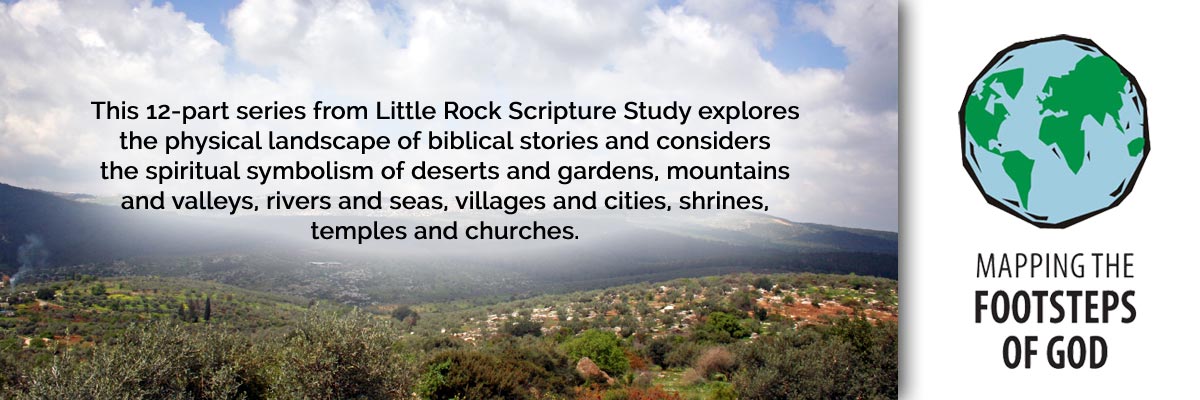Official Website of the
Catholic Diocese of Little Rock
The early Church assembled in houses
Published: December 18, 2014
This is the 12th column in a 12-part series.
By By Clifford M. Yeary
Associate Director, Little Rock Scripture Study
Sacred Scripture has provided us with a map of God’s footsteps: in recording the mighty deeds of God, specific places have been named as the settings in which God’s plan for our salvation gradually unfolded.

In this final article in the series, we explore not one set place, but the myriad locales in which the passion and resurrection of our Lord became the focus of Christian worship. Throughout the Roman Empire, wherever the name of Christ was proclaimed and believers united with him through baptism, the Eucharist was also celebrated as an encounter with his passion and resurrection.
In early Christianity, there were no church buildings. Eucharist was celebrated by the Church — that is, the Body of Christ — assembled together in private homes. Referred to as house churches today, in their own time, these Christians would have thought of themselves as the Church and the place where they assembled as someone’s house. Note how Paul greeted the Christians in Corinth: “The churches of Asia send you greetings. Aquila and Prisca together with the church at their house send you many greetings in the Lord” (1 Corinthians 16:19).
The sacredness of these places did not arise from their architecture, it resided in the presence of those gathered — the assembling of the local Body of Christ — and in what they had gathered together to receive, the Body of Christ in the signs of bread and wine.
The late Father Jerome Murphy-O’Connor’s masterful book, “St. Paul’s Corinth,” reveals a great deal about these early house churches. One of the more surprising revelations in his book is how few Christians comprised the Church in Corinth. With all the problems Paul had to deal with among the Corinthians, it would seem that it ought to have taken a lot more people to get into that much trouble!
Based on archeological findings in Corinth, it is very unlikely that Paul is addressing a Church of more than 50 people. It might have been even smaller. Forty may be a safer guess. These small numbers are based on the size of houses in Corinth, and the house that Murphy-O’Connor used as his primary example was the spacious abode of someone with considerable wealth.
Examining the architectural remains of that house adds color to our understanding of Paul’s criticism of the manner in which the Corinthians were attempting to celebrate the Eucharist. We know that it was common in the early days of the Church for the Lord’s Supper to be celebrated in the context of a larger meal that was referred to as an “agape,” or love feast (see verse 12 of Jude).
If 40 or 50 were to have gathered in one of Corinth’s larger houses, it would have taken at least two rooms to accommodate them. Traditionally, meals would have been served in the triclinium, a dining room where guests would recline on couches which took up a lot of room. If a crowd had come to the house for an agape meal, only the most favored guests — most likely the wealthiest — would have been served there. The others would be relegated to the atrium, a room that was open to the elements from above and where they would be seated on the floor.
Paul claims that during these gatherings, the fact that some were well-fed and getting drunk while others went hungry, proved that their meals failed the test of a genuine Eucharist (1 Corinthians 11:17-22). In a real Eucharist, they would recognize and respect each other as the Body of Christ.
Paul then describes for them the tradition he received concerning the Last Supper as the foundation for the celebration of Eucharist (1 Corinthians 11:23-27). Written before any of the Gospels, it is the earliest known written tradition concerning the Last Supper. Luke’s account of the Last Supper (Luke 22:14-20) bears the closest resemblance to Paul’s account.
For all their scandalous behavior, we are grateful to have Paul’s response to the Corinthians. From it we learn of the centrality of the Eucharist to the traditions Paul taught as well as much about early Christian communities.
House churches have not altogether disappeared, either, even within Catholicism. Today, in China, many Catholics have banded together to worship in their houses as clergy loyal to the pope are denied the opportunity to celebrate Eucharist in physical churches. Today, as always, we can see God’s footsteps, if we are looking for them.
Study Questions
- The Catechism describes the Church as “the family of God” (§ 1655). What are some simple steps modern families could take to make their family homes something of a house church?
- What might Christians today learn from the experience of house church in Corinth?
- While the Eucharist is no longer celebrated in the context of a meal, what are some occasions when your local church feasts together that are an important part of parish life? What is it about them that make them important?
- What importance do you see in Paul’s teaching that we who gather together in Christ’s name are the actual Church, rather than the building in which we gather?
This article was originally published in Arkansas Catholic Dec. 13, 2014. Copyright Diocese of Little Rock. All rights reserved. This article may be copied or redistributed with acknowledgement and permission of the publisher.




